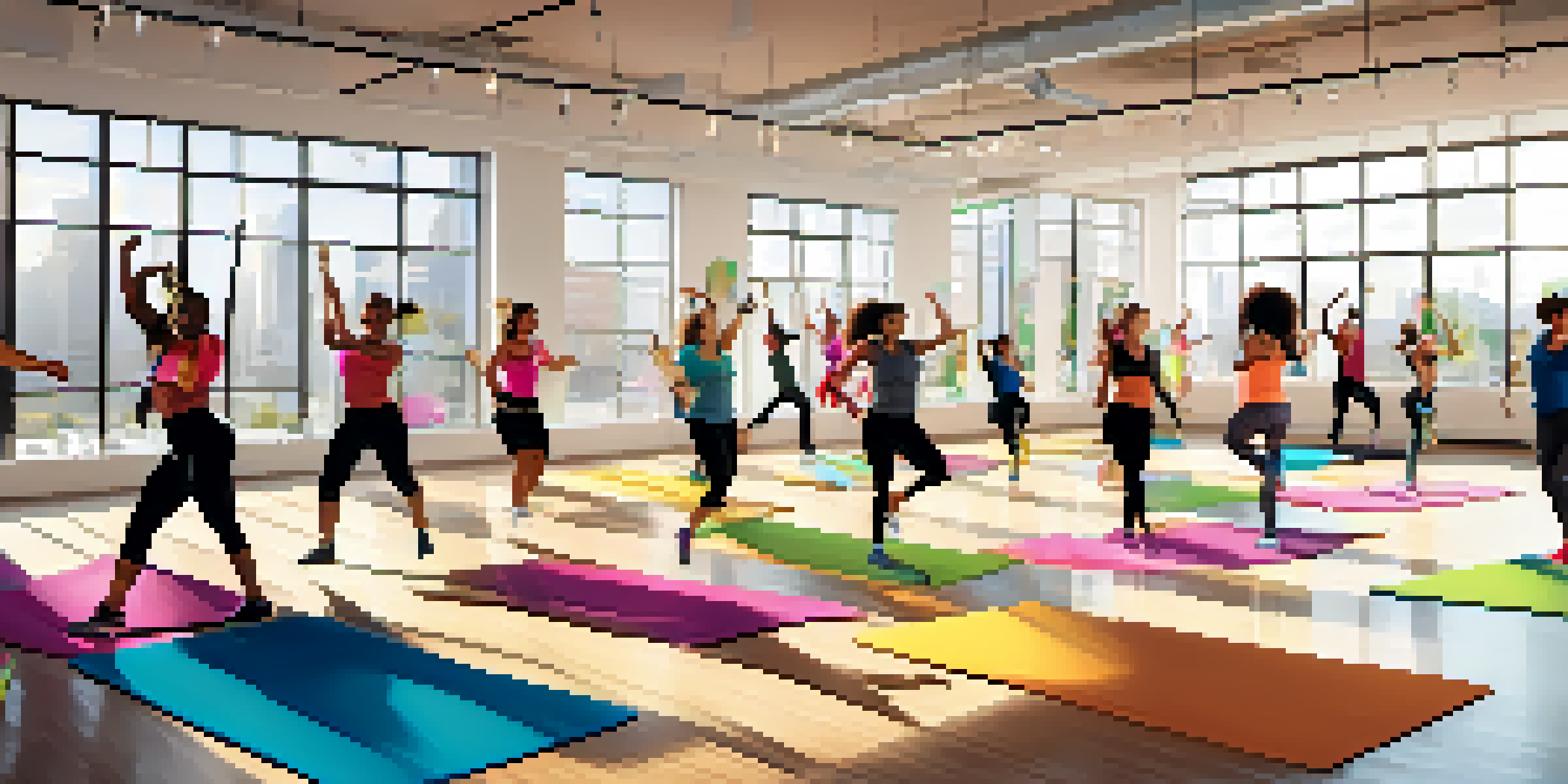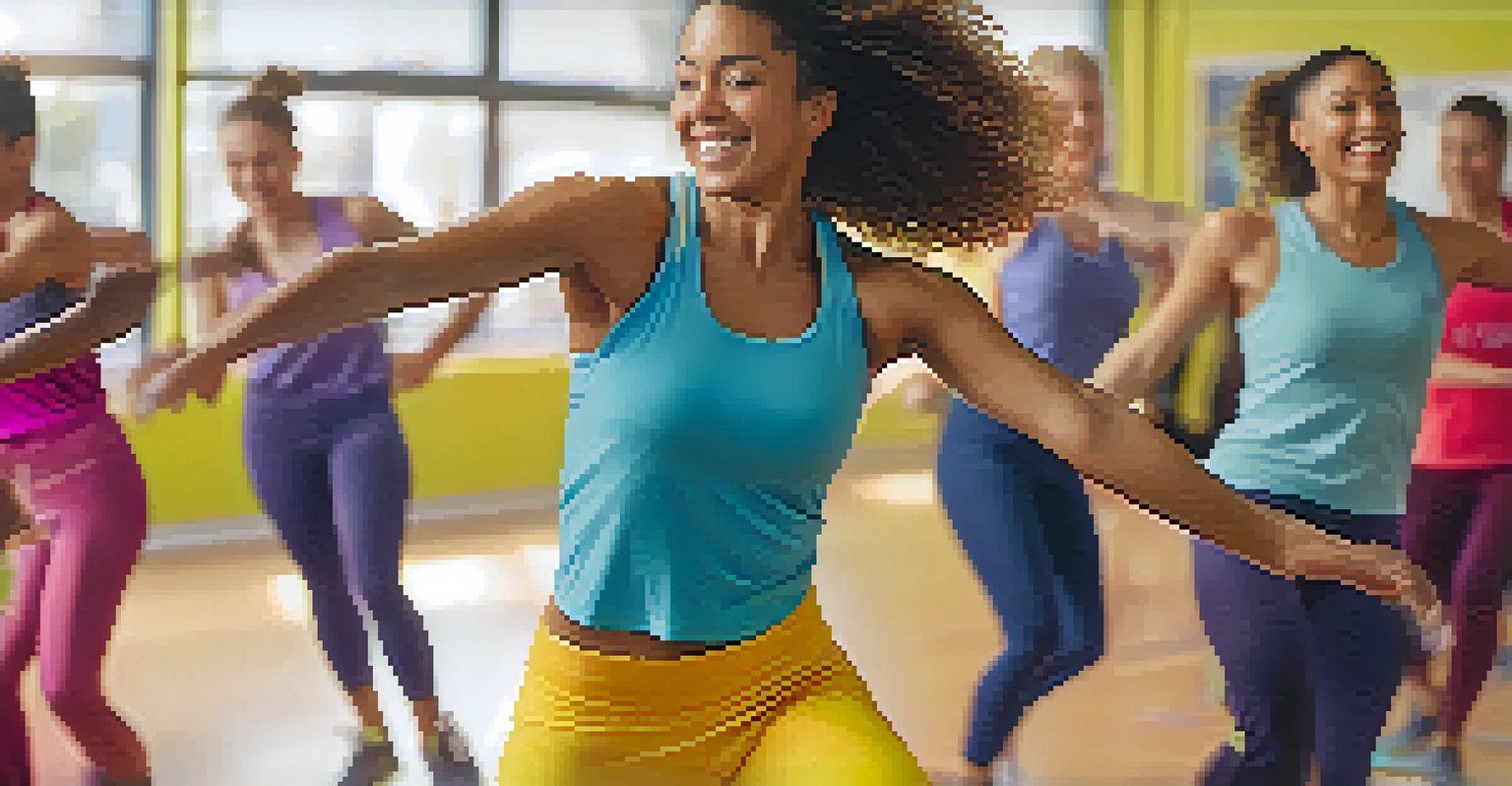Dance Fitness Classes: Energizing Employees at Work

What Are Dance Fitness Classes and Why They Matter
Dance fitness classes combine the joy of dancing with physical fitness, creating an engaging workout experience. These sessions often feature upbeat music and rhythmic movements that allow participants to express themselves while getting fit. In a workplace setting, they can serve as a refreshing break from the daily grind, leading to improved mood and energy levels.
Dancing is like dreaming with your feet.
By integrating dance into fitness routines, employees not only enhance their physical health but also foster social connections. This communal aspect encourages team bonding, making it easier for colleagues to break down barriers and communicate more effectively. Ultimately, a happy and energetic workforce leads to greater productivity and a positive work environment.
Moreover, dance fitness classes can be tailored to meet employees’ varying skill levels, ensuring everyone can join in on the fun. This inclusivity helps to create a culture of health and wellness within the workplace, encouraging employees to prioritize their physical and mental well-being.
The Benefits of Dance Fitness for Employees
One of the most significant benefits of dance fitness is stress relief. Engaging in physical activity like dancing releases endorphins, which are natural mood lifters. This means that after a lively dance session, employees often feel more relaxed and ready to tackle their tasks with renewed focus.

Additionally, dance fitness classes can improve employees' physical health by increasing their cardiovascular fitness and flexibility. As employees become more active, they may also notice improvements in their energy levels throughout the day. This, in turn, can lead to fewer sick days and a healthier workforce overall.
Boost Employee Well-being
Dance fitness classes enhance physical health and mental well-being, leading to a happier workforce.
Finally, these classes can enhance cognitive function. Studies have shown that physical activity stimulates brain activity, leading to better concentration and memory. When employees feel good physically, they are better equipped to think creatively and solve problems efficiently.
Creating a Dance Fitness Program at Work
Starting a dance fitness program in the workplace can be a straightforward process. First, gather interest from employees to gauge participation levels. This can be done through surveys or informal meetings, allowing employees to express their preferences for class times and styles.
The dance is a poem of which each movement is a word.
Next, consider hiring a qualified instructor who specializes in dance fitness. A skilled instructor can ensure that classes are engaging, safe, and suitable for all fitness levels. Moreover, they can introduce various dance styles, from Zumba to hip-hop, keeping the sessions fresh and exciting.
Finally, promote the program internally to build enthusiasm. Use company newsletters, bulletin boards, or social media channels to highlight upcoming classes and share success stories from participants. This will help foster a sense of community and encourage more employees to join in.
Overcoming Barriers to Participation
One common barrier to participation in dance fitness classes is the fear of judgment. Employees may worry about their dancing skills or feel self-conscious in a group setting. To combat this, it's important to create an inclusive and supportive environment where everyone is encouraged to have fun, regardless of their dance experience.
Another challenge can be time constraints. Employees often feel overwhelmed by their workloads and may hesitate to commit to additional activities. To address this, consider offering short, 30-minute classes during lunch breaks or after work hours, making it easier for employees to fit fitness into their schedules.
Foster Team Bonding
These classes create a communal environment, helping to break down barriers and improve communication among colleagues.
Lastly, some employees may not see the immediate benefits of participating in dance fitness. To help with this, share testimonials and success stories from team members who have benefited from the program. Highlighting improvements in mood, energy levels, and even team dynamics can motivate others to join in.
Measuring the Success of Dance Fitness Classes
To ensure that the dance fitness program is effective, it's essential to track its success through various metrics. Start by collecting feedback from participants after each class to understand their experiences and suggestions for improvement. This feedback can help tailor future sessions to better meet the needs of employees.
Additionally, monitor attendance rates to gauge interest and engagement over time. A steady increase in participation can indicate that employees are finding value in the classes. Conversely, a drop in attendance may signal the need for changes, such as different scheduling or a new instructor.
Finally, consider measuring the overall impact on employee well-being and productivity through surveys or performance reviews. By assessing changes in morale and energy levels, you can demonstrate the tangible benefits of dance fitness classes to management and encourage ongoing support for the program.
Incorporating Dance Fitness into Company Culture
Integrating dance fitness classes into the company culture can significantly enhance employee engagement and satisfaction. By making wellness a priority, employers show their commitment to their employees' physical and mental health. This positive reinforcement can lead to a more motivated and loyal workforce.
Encouraging participation in dance fitness can also foster a sense of belonging among employees. When colleagues come together to share in a fun and energetic activity, they build relationships that can translate into better collaboration and teamwork in the workplace.
Simple Program Implementation
Starting a dance fitness program is easy and can be tailored to fit employees' schedules and skill levels.
To embed dance fitness into the company culture, consider organizing regular events, such as dance challenges or themed classes. This not only keeps the momentum going but also adds an element of excitement that employees can look forward to, further strengthening their connection to the workplace.
Conclusion: Dance Fitness as a Workplace Essential
In conclusion, dance fitness classes are more than just a fun activity; they are a powerful tool for energizing employees and promoting overall well-being. By providing a creative outlet for stress relief and encouraging physical activity, these classes can significantly enhance workplace morale and productivity.
As organizations seek to cultivate healthier work environments, integrating dance fitness into employee wellness programs can yield long-lasting benefits. Employees who feel valued and healthy are more likely to contribute positively to the company's success.

Ultimately, making dance fitness a regular part of workplace culture can lead to happier, healthier, and more engaged employees. By investing in their well-being, companies can create a thriving environment where everyone can dance their way to success.